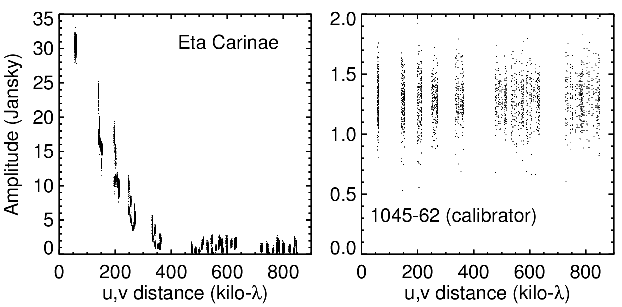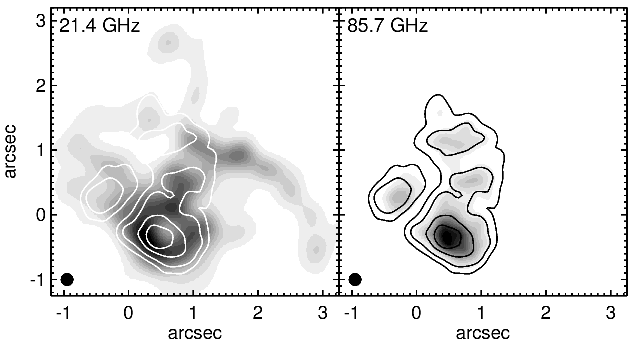Who needs high altitudes?
I thought gloomily about these maxims as I drove from Sydney to Narrabri for a Compact Array observation at 3 mm wavelength on 3 km baselines and saw cloudy skies. I was in a bit of a hurry, actually, since my observing time had already started. As per usual, I had been cutting it fine, planning to arrive just the day before the observation, but my flight from Washington to Los Angeles had mechanical problems and by the time they flew in a spare part from Boston, it was way too late to connect to the Sydney flight, and I had to spend an extra day in Los Angeles. This turned out to be an experience in itself. When I woke up late the local TV stations were already providing wall-to-wall helicopter coverage of a freeway chase. We don't have that on the east coast. We have plenty of freeways, so we must have freeway chases, but there's no TV coverage. It's a California thing.
Then after lunch there was an earthquake. Quite a big earthquake. I was sitting on the bed working at my laptop, in a room on the first floor of the hotel near the airport, when everything started shaking. It lasted about 10 seconds and everything shook pretty well: if it had gone on any longer the enormous TV would have fallen off the table it was on. The earthquake was big enough to interrupt the freeway chase coverage, and an hour later we were promised a press conference live from the Jet Propulsion Laboratory. I duly watched the tectonics expert from Caltech assure the press that this was just an ordinary earthquake, not related to the much larger one that occurred a week earlier, hundreds of miles offshore, a thousand miles away on a completely different fault. It was just another day in LA. (It's a California thing.)
Anyway, there I was driving up the Hunter Valley, watching the high cloud increase and listening to the forecast of rain moving into the state from the south-west. I was resigning myself to an unsuccessful track, which was OK; after all, you can't expect to do millimetre interferometry on 3 km baselines at just 200 m altitude near the tropics in a warm country. Every millimetre astronomer knows that.
So I get to Narrabri and blearily make my way to the control building (for the second time: I had of course forgotten the combination and it was the weekend). I had sent an e-mail to Bob Sault warning him that I would be late and he agreed to run the observation until I arrived. Bob is sitting there in the control room, programming away. I greet him and start to commiserate about the weather. But Bob stops me and says, with that inflection of his that makes it sound as if he had been sagely pondering this for hours, that it's going fine. Even on the long baselines, I ask? Yep, he grunts. And sure enough, I look at the screen and it is going fine. Really fine. Who would believe it? Millimetre interferometry on 3 km baselines practically at sea level, almost in the tropics, with clouds. It's just not right.

Figure 1: Amplitude versus u,v distance over 3 km baselines at 3 mm wavelength for Eta Carinae
(left) and the phase calibrator 1045-62 (right); click on image for larger version.
Now, I probably should have mentioned that the target was Eta Carinae. Sometimes I think that Eta Car was put in the southern sky just for the Compact Array. The spatial scales of Eta Car's emission match the Compact Array's longest baselines perfectly and scale with wavelength as the array's resolution does. Plus, it satisfies the other maxim of millimetre interferometry, the one I omitted above: it has flux. Lots of flux, concentrated in a small area. In fact, more flux than any of the calibrators and most of the planets. There is no source remotely like it in the northern sky. The flux comes from gas in the dense outflow from a binary system containing two hot stars in a highly elliptical 5.5 year orbit. As the hotter secondary star moves out of the very dense wind of the primary, its UV photons are able to ionise increasing amounts of gas some distance away in the outflow and the resulting optically-thick thermal emission at about 104 K brightness temperature provides the radio flux. At 87 GHz it was 2 Jy at its minimum in 2003, when the hot star was buried deep in the wind of the primary, 14 Jy a year later, and now, as Bob sat by calmly, it was an astonishing 30 Jy from a region not much more than 1 arcsec across. Plots of amplitude versus baseline length are shown in Figure 1 for the phase calibrator (1045-62) and for Eta Car (different amplitude scales). This flux level is the key to the observation, since it permits self-calibration to remove atmospheric phase fluctuations on the shortest timescales; without this the observation would not have been successful.
The benefit of this success is that we can achieve a nominal resolution of 0.2 arcsec with 3 km baselines at 3 mm wavelength. The resulting image is compared in Figure 2 with the 21 GHz image from a few days later, both at 0.2 arcsec resolution (the 21 GHz image is somewhat super-resolved, and the astrometry of the 86 GHz image could not be preserved so the relative positions of the 21 and 86 GHz images are arbitrary). The 86 GHz image shows what the visibility plot already foretold: the source is well resolved at this spatial scale. The dynamic range in the 86 GHz image is over 100. The peak brightness temperature is 9400 K at 21 GHz, but almost 15,000 K at 86 GHz, suggesting that the temperature increases as you go in towards the central region of the source.

Figure 2: Compact Array observations of Eta Carinae in 2005 June at 21 GHz (left) and 86 GHz
(right). The resolution is 0.2 arcsec in both images (beam size shown at lower left). Contours of the
86 GHz emission are overplotted in white on the 21 GHz grey scale image. The overlay is chosen to
try to match the 86 to the 21 GHz emission: the astrometry at 86 GHz did not survive self-calibration
(click on image for larger version).
Normally the problem with observing over long baselines at millimetre wavelengths is that within one integration time the phase difference along the atmospheric paths to a pair of telescopes varies by so much that the vector sum of the visibility data suffers amplitude loss. However, you can't always tell what atmospheric conditions will be like just by looking at the sky. Frequently at Hat Creek we would have cold clear days right after a front passed through that looked like great observing days, but the atmospheric phases fluctuated rapidly due to turbulent moisture at a certain height that made the data useless. Similarly, in this case the high cloud actually represents a smooth atmosphere at the appropriate height, so that despite the extra moisture in the atmosphere the timescale for large phase fluctuations is not too severe, minutes rather than seconds, allowing a successful observation for an object with enough flux to be self-calibrated. But the bottom line is that we were a bit lucky that this track was so successful: millimetre astronomers don't have those morose maxims for nothing!
Stephen White
University of Maryland, College Park, USA
(swhite@astro.umd.edu)
